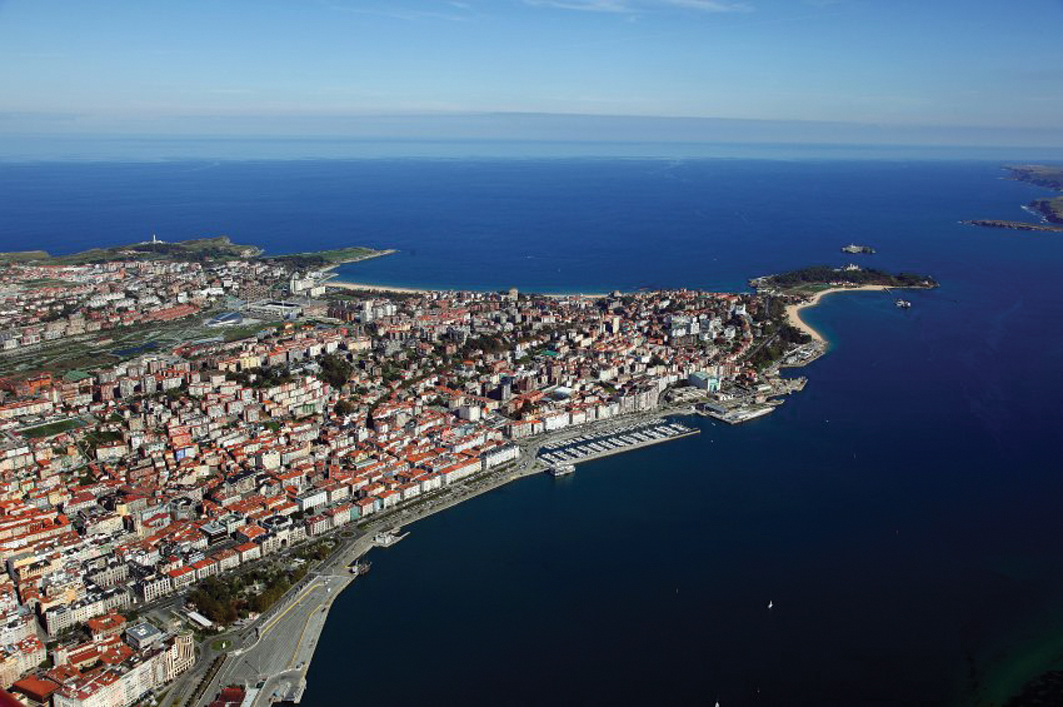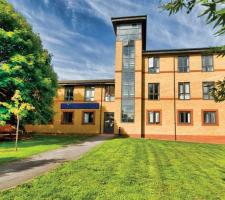
Santander is a close packed city allowing saturation-level deployment of sensors
David Crawford reports on an urban electronic nervous system.
The northern Spanish city of Santander – historically a port - is now an emerging technology showcase attracting global attention as a prototype for a medium-sized Smart city of the future. In a move to determine the optimal use of available data, it is creating a de-facto experimental laboratory for sensor and mobile phone-based urban traffic management and environmental monitoring innovations.
Santander has a population of 190,000 and is the leading member of a wider project embracing cities in three other EU Member States. It is being equipped with a wireless electronic nervous system by a consortium including the municipality, the University of Cantabria and Telefonica I+D (the research and development arm of the Spanish telecoms company) which is delivering the underlying machine-to-machine (M2M) platform. The pilot system covers the city’s central business district – an area of 6km2 - with an array of more than 10,000 sensors, 2,000 of which are already in place.
At the same time, Mayor Iñigo de la Serna – a civil engineer specialising in transport – is progressively converting individual residents into sensors for, as well as recipients of, environmental and transport data. This is done through the use of the Pulso de la Ciudad (City Pulse) mobile iPhone app. Not only can the user point at a bus stop in order to access next service arrival times, they can also, for example, photograph and send GPS location-referenced details of roadway or footway faults or traffic incidents direct to the municipal offices.
From here, the information goes to the relevant officials who deal with the technical or political responsibility for the particular issue. All of the resulting data (apart from the identity of the complainant) is made publicly available. Both residents and local media can use the app to check how long it takes to remedy the problem, as part of what de la Serna describes as a “cooperative relationship between the people and the city government”.
Data from742 SmartSantander sensors is being used to enhance existing traffic information in order to deliver more accurate estimates of real-time flows throughout the city and keep drivers informed. The existing database stores both historical and real-time sensor records and draws on flow estimation and traffic assignment models. Over time the use of data on the web and mobile applications will be included to enable consistent and effective reporting on real-time traffic conditions.
Every bus, for example, is being equipped to continuously and wirelessly transmit not only information on its position, mileage and speed, but also data gathered from its environment such as ozone or nitric oxide pollution levels. Sensors fitted inside the waste bins will be able to issue automatic alerts when the collected rubbish reaches a level where the bin needs emptying. This information will be used to rationalise the deployment of refuse collection vehicles and so avoid making unnecessary trips – an integral part of the city’s bid to cut waste-management bills by up to 20% a year.
Fitting nodes to streetlights has a triple purpose: to minimise the visual impact on the city’s streetscape, to take advantage of an available power source and to act as repeaters in a nodal data transmission chain (see panel). Each unit contains the electrical equipment necessary for telecommunication connection without affecting the streetlights’ basic safety role.
Indeed street lighting management is itself a beneficiary of the project because the technology enables the ending of a previous costly regime of night patrols to check for operational faults. Now the central system computer alerts maintenance crews to any faults and can also adjust the lamps’ brightness as appropriate, dimming them in the absence of pedestrian activity or when there is a full moon as opposed to rain. This again saves money on city budgets by ending the current practice of setting lighting levels at maximum for the whole period of darkness and does so while maintaining pedestrian safety.
These linked problems are the subject of a sub-project for Spanish start-up company740 Libelium which has saturated the city centre with a network of 1,200 Waspmote low-power nodes. Of these, 825 measure environmental parameters including temperature, luminosity, CO emissions and noise, while the remaining 375 monitor parking availability using magnetic field detection.
Each node carries up to six different sensor probes which are powered by rechargeable batteries and can integrate GPS capability for accurate position and time referencing. The temperature sensor can measure ambient temperature from -40ºC to 125 ºC while the CO sensor detects changes in concentration of carbon monoxide from 30ppm to 1000 ppm and enables the creation of detailed pollution maps. Inside the nodes the hardware is identical which reduces infrastructural costs because it allows the environmental sensors to double as repeaters (see panel). If any parameter rises above a pre-set threshold, the system can analyse the relevant data and react by sending an alarm to the nearest gateway node.
The gateway node gathers the data from all the sensors within its zone, stores it in a database and sends the information to the SmartSantander backbone through a 3G or ethernet connection. For the purposes of this deployment, the city centre is divided into 22 zones, each equipped with a gateway node (see panel) – Libelium’s Meshlium product which is designed to read and store data for onward transmission. Its CEO Alicia Asín Pérez told ITS International: “Of course the 375 parking sensors are not enough to cover the city’s available spaces. But this is a very substantial pilot and the municipality may consider expanding it in future.”
The results of this data gathering are communicated to motorists via strategically-located screens which are updated every five minutes. In the longer term the city authorities can use the resulting information to detect the location of recurring traffic jams and air pollution black spots and monitor environmental parameters as the basis for policy initiatives and target further research. Noise and ozone maps show which areas are exceeding EU limits and, by publishing the results and creating an interactive map, the city can keep its electorate informed of environmental issues and its responses.
To minimise battery power consumption the nodes are designed with three modes. This allows them to sleep for most of the time between the pre-set wake UPS for sensor reading and wireless data communication prior to reverting.
Deployment of the wireless sensor network has been carried out by Spanish engineering companies IDOM and TTI Norte. This followed a detailed coverage study on the most effective positioning location of nodes to maximise the area covered by the project. Libelium is also supplying additional sensors that are being used in third-party solutions by Spanish company Fagor for on-bus deployment.
5650 Ericsson, EkoBus– like Santander – is using buses fitted with sensors to monitor environmental parameters. Passengers can also check bus locations and estimated arrival times.
In the UK, the Centre for Communication Systems Research (CCSR) at the University of Surrey in Guildford has equipped the interior of its building with 200 nodes, developed internally and each equipped with sensors for detecting motion, temperature, light and noise. These are monitoring the movements of people, as well as area security status and energy consumption, with the aim of building up a database of real-time usage profiles.
CCSR plans to roll this system out into the town of Guildford in locations including public buildings and transport hubs and its involvement in SmartSantander forms part of a cluster of projects in the EC’s 7th R&D Framework’s Future Internet Public-Private Partnership Programme (FIPPP). This is set up in five European city clusters to develop use cases for developing new internet services and products.
In Birmingham (UK), CCSR has worked on developing the Travelsmarter multi-modal incentive-driven approach aimed at encouraging transport users to opt for specific modes, for instance by opting for cycling or walking to help reduce bus or tram dependence for short trips.
The results of its activities are now feeding into a new project which will focus on travel safety. In Santander, OUTSMART has supported the city’s drive for the rationalisation of streetlight use.
SmartSantander is funded by the EU through the Future Internet Research and Experimentation (FIRE) programme. Santander’s own upfront investment in its network is €8.6 million, with the bulk coming from an EU grant.
Mayor de la Serna is confident that the network will be largely self-sustaining, with utility companies and city contractors covering much of the cost of expansion out of the savings that they are expected to make.
The SmartSantander development team is being led by the University of Cantabria engineering department, whose laboratory is serving as the central location for collecting data streams from throughout the city.
Architecture
The SmartSantander parking and environmental array operates on a three-tiered basis:
•The basic node senses the required parameters;
•Repeaters, placed high above ground on streetlights, traffic signs and information panels act both as additional environmental sensors and as forwarding repeaters for the onward transmission of information received from other nodes;
•Gateways, also placed high above ground to maximise coverage, act as the link between the sensor networks and the SmartSantander backbone.
The infrastructure is designed to simultaneously accommodate the standard delivery of public services (such as outdoor parking control and environmental monitoring) and give scope for researchers and testing of new IoT technologies and products. There is evidence of strong interest from commercial companies including Ericsson and Alcatel-Lucent in the potential of this readily-available testbed, which allows nodes to be flashed over the air, using a solution based on hardware independence.
All nodes can be equipped with two radio modules communicating at 2.4GHz, supplied by US-based M2M specialist Digi – one for service provision and network management, the other to handle experimental data traffic. To deliver both of these roles effectively, communication between nodes follows the Testbed Runtime protocol developed within the European WISEBED research project.
The northern Spanish city of Santander – historically a port - is now an emerging technology showcase attracting global attention as a prototype for a medium-sized Smart city of the future. In a move to determine the optimal use of available data, it is creating a de-facto experimental laboratory for sensor and mobile phone-based urban traffic management and environmental monitoring innovations.
Santander has a population of 190,000 and is the leading member of a wider project embracing cities in three other EU Member States. It is being equipped with a wireless electronic nervous system by a consortium including the municipality, the University of Cantabria and Telefonica I+D (the research and development arm of the Spanish telecoms company) which is delivering the underlying machine-to-machine (M2M) platform. The pilot system covers the city’s central business district – an area of 6km2 - with an array of more than 10,000 sensors, 2,000 of which are already in place.
At the same time, Mayor Iñigo de la Serna – a civil engineer specialising in transport – is progressively converting individual residents into sensors for, as well as recipients of, environmental and transport data. This is done through the use of the Pulso de la Ciudad (City Pulse) mobile iPhone app. Not only can the user point at a bus stop in order to access next service arrival times, they can also, for example, photograph and send GPS location-referenced details of roadway or footway faults or traffic incidents direct to the municipal offices.
From here, the information goes to the relevant officials who deal with the technical or political responsibility for the particular issue. All of the resulting data (apart from the identity of the complainant) is made publicly available. Both residents and local media can use the app to check how long it takes to remedy the problem, as part of what de la Serna describes as a “cooperative relationship between the people and the city government”.
Data from
Environmental sensing
Sensor arrays are continuously tracking and relaying data on key environmental parameters – luminosity, air pressure, noise, temperature, humidity and pollution. This is in addition to the movements of cars and people and all the data is used to build up a picture of the state of the city, at rest and in motion, at any given time. Some of the sensor nodes are being buried beneath the city streets or the parking spaces; others are mounted on streetlights or other conveniently-located items of urban street furniture. Buses and other public service vehicles including police cars and taxis are also being fitted and there are sensors located inside public waste bins.Every bus, for example, is being equipped to continuously and wirelessly transmit not only information on its position, mileage and speed, but also data gathered from its environment such as ozone or nitric oxide pollution levels. Sensors fitted inside the waste bins will be able to issue automatic alerts when the collected rubbish reaches a level where the bin needs emptying. This information will be used to rationalise the deployment of refuse collection vehicles and so avoid making unnecessary trips – an integral part of the city’s bid to cut waste-management bills by up to 20% a year.
Fitting nodes to streetlights has a triple purpose: to minimise the visual impact on the city’s streetscape, to take advantage of an available power source and to act as repeaters in a nodal data transmission chain (see panel). Each unit contains the electrical equipment necessary for telecommunication connection without affecting the streetlights’ basic safety role.
Indeed street lighting management is itself a beneficiary of the project because the technology enables the ending of a previous costly regime of night patrols to check for operational faults. Now the central system computer alerts maintenance crews to any faults and can also adjust the lamps’ brightness as appropriate, dimming them in the absence of pedestrian activity or when there is a full moon as opposed to rain. This again saves money on city budgets by ending the current practice of setting lighting levels at maximum for the whole period of darkness and does so while maintaining pedestrian safety.
City centre issues
The project is putting particular emphasis on Smart parking and environmental monitoring as finding a parking space is recognised as being a serious contributor to urban air and noise pollution, congestion and economic pressures. Across the EU Member States the European Commission estimates traffic delays and congestion cost €150bn per year with the search for vacant parking spaces playing a major role as well as causing stress for motorists and creating implications for road safety.These linked problems are the subject of a sub-project for Spanish start-up company
Each node carries up to six different sensor probes which are powered by rechargeable batteries and can integrate GPS capability for accurate position and time referencing. The temperature sensor can measure ambient temperature from -40ºC to 125 ºC while the CO sensor detects changes in concentration of carbon monoxide from 30ppm to 1000 ppm and enables the creation of detailed pollution maps. Inside the nodes the hardware is identical which reduces infrastructural costs because it allows the environmental sensors to double as repeaters (see panel). If any parameter rises above a pre-set threshold, the system can analyse the relevant data and react by sending an alarm to the nearest gateway node.
The gateway node gathers the data from all the sensors within its zone, stores it in a database and sends the information to the SmartSantander backbone through a 3G or ethernet connection. For the purposes of this deployment, the city centre is divided into 22 zones, each equipped with a gateway node (see panel) – Libelium’s Meshlium product which is designed to read and store data for onward transmission. Its CEO Alicia Asín Pérez told ITS International: “Of course the 375 parking sensors are not enough to cover the city’s available spaces. But this is a very substantial pilot and the municipality may consider expanding it in future.”
The results of this data gathering are communicated to motorists via strategically-located screens which are updated every five minutes. In the longer term the city authorities can use the resulting information to detect the location of recurring traffic jams and air pollution black spots and monitor environmental parameters as the basis for policy initiatives and target further research. Noise and ozone maps show which areas are exceeding EU limits and, by publishing the results and creating an interactive map, the city can keep its electorate informed of environmental issues and its responses.
To minimise battery power consumption the nodes are designed with three modes. This allows them to sleep for most of the time between the pre-set wake UPS for sensor reading and wireless data communication prior to reverting.
Deployment of the wireless sensor network has been carried out by Spanish engineering companies IDOM and TTI Norte. This followed a detailed coverage study on the most effective positioning location of nodes to maximise the area covered by the project. Libelium is also supplying additional sensors that are being used in third-party solutions by Spanish company Fagor for on-bus deployment.
Across Europe
The project as a whole involves the deployment of 20,000 sensors in the European cities of Belgrade (Serbia), Guildford (UK) and Lübeck (Germany) as well as in Santander itself, which is leading the field with its tally of 10,000-plus. Belgrade, together with its neighbour, Panevo, which lies 15km to the northeast of the Serbian capital, is piloting an EkoBus system. Developed in collaboration with Swedish telecoms companyIn the UK, the Centre for Communication Systems Research (CCSR) at the University of Surrey in Guildford has equipped the interior of its building with 200 nodes, developed internally and each equipped with sensors for detecting motion, temperature, light and noise. These are monitoring the movements of people, as well as area security status and energy consumption, with the aim of building up a database of real-time usage profiles.
CCSR plans to roll this system out into the town of Guildford in locations including public buildings and transport hubs and its involvement in SmartSantander forms part of a cluster of projects in the EC’s 7th R&D Framework’s Future Internet Public-Private Partnership Programme (FIPPP). This is set up in five European city clusters to develop use cases for developing new internet services and products.
In Birmingham (UK), CCSR has worked on developing the Travelsmarter multi-modal incentive-driven approach aimed at encouraging transport users to opt for specific modes, for instance by opting for cycling or walking to help reduce bus or tram dependence for short trips.
The results of its activities are now feeding into a new project which will focus on travel safety. In Santander, OUTSMART has supported the city’s drive for the rationalisation of streetlight use.
SmartSantander is funded by the EU through the Future Internet Research and Experimentation (FIRE) programme. Santander’s own upfront investment in its network is €8.6 million, with the bulk coming from an EU grant.
Mayor de la Serna is confident that the network will be largely self-sustaining, with utility companies and city contractors covering much of the cost of expansion out of the savings that they are expected to make.
The SmartSantander development team is being led by the University of Cantabria engineering department, whose laboratory is serving as the central location for collecting data streams from throughout the city.
Architecture
The SmartSantander parking and environmental array operates on a three-tiered basis:
•The basic node senses the required parameters;
•Repeaters, placed high above ground on streetlights, traffic signs and information panels act both as additional environmental sensors and as forwarding repeaters for the onward transmission of information received from other nodes;
•Gateways, also placed high above ground to maximise coverage, act as the link between the sensor networks and the SmartSantander backbone.
The infrastructure is designed to simultaneously accommodate the standard delivery of public services (such as outdoor parking control and environmental monitoring) and give scope for researchers and testing of new IoT technologies and products. There is evidence of strong interest from commercial companies including Ericsson and Alcatel-Lucent in the potential of this readily-available testbed, which allows nodes to be flashed over the air, using a solution based on hardware independence.
All nodes can be equipped with two radio modules communicating at 2.4GHz, supplied by US-based M2M specialist Digi – one for service provision and network management, the other to handle experimental data traffic. To deliver both of these roles effectively, communication between nodes follows the Testbed Runtime protocol developed within the European WISEBED research project.















